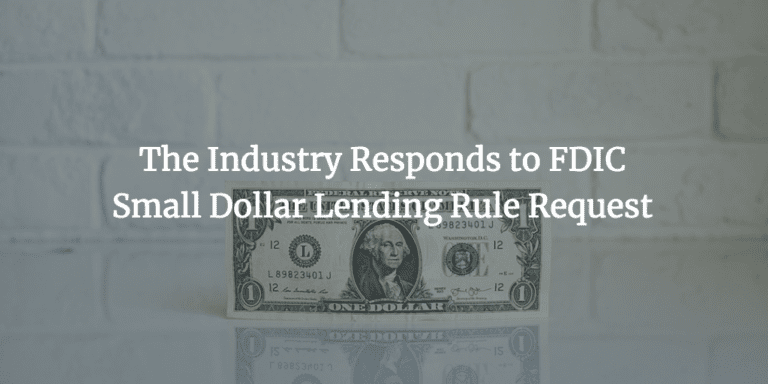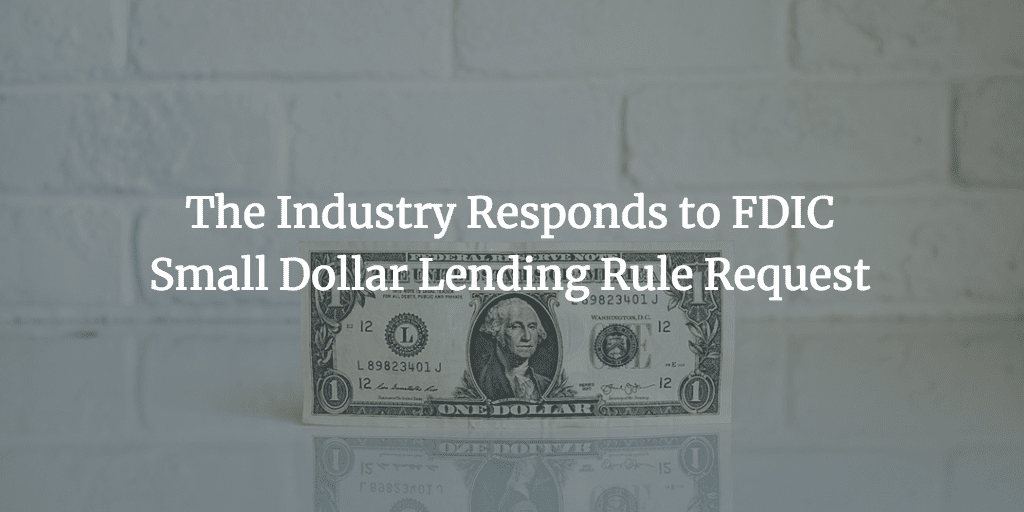Small dollar loans can be quite profitable. Just look at the number of payday loan stores in the US, there are more than 20,000 of them. The reason they can be so profitable is that four out of five payday loans are rolled over or renewed according to the CFPB. For the most part banks have stayed away from actively promoting a small dollar loan product and the FDIC wanted to know why and what conditions might lead to them to offer them.
So, back in November the FDIC issued a Request for Information on Small Dollar Lending. They received more than 60 responses from banks, industry associations, non-profit groups, fintech companies and individuals. While each group had a slightly different perspective there was an acknowledgement of the challenge of making small dollar loans both affordable for consumers and profitable. While the FDIC did not define exactly what they meant by a small dollar loan the respondents, for the most part, took it to mean loans of less than $5,000.
There are many mainstream online lenders offering personal loans down to $1,000 and there are also many fintech companies offering loans under $1,000. Companies like Oportun, Insikt, LendUp, Elevate, Opploans and many others offer these sub-$1,000 loans using the latest technology tools to make this process more efficient. Often these companies partner with banks to facilitate these loans to underserved consumers. But there are few banks offering online sub-$1,000 loans directly with a notable exception being US Bank. Interestingly, they did not respond to the FDIC request.
Many industry associations did respond and I provide a summary of a few of these responses below.
The Marketplace Lending Association (MLA) provided a detailed 10-page response where they urged the FDIC (and other regulators) to do more to support banks and foster closer working relationships with fintech providers:
This includes establishing clarity by regulation on the valid-when-made principle that was undermined by the 2015 Madden decision, and finalizing the proposed FIL-50 Third Party Lending Guidance to help guide how banks can, and should, manage a bona-fide third-party lending arrangement. As the FDIC reviews finalizing FIL-50, it can also address unnecessary “true lender” uncertainty arising from certain older abusive payday lender-bank partnerships.
The MLA also made the case for the increasing role of new kinds of partnerships between banks and fintech companies that can provide a better outcome for consumers:
Evidence from a range of sources, including Transunion, dv01, Federal Reserve researchers and academic researchers indicate that innovative banks, working in various ways with technology providers, such as MLA members, are helping to fill these critical gaps and providing responsible “smaller dollar” credit options to millions of Americans who need them. These partnerships are well-regulated and clearly bring benefits to consumer, banks and our economy.
The American Bankers Association (ABA), the leading trade association for large banks, explained that many of their member banks do offer small dollar loans but only a minority offer these loans as part of an established program. The impediment, according to the ABA, is the FDIC’s 2013 Direct Deposit Advance Guidance that made it very difficult for banks to underwrite small dollar loans:
ABA believes that the banking industry can and should continue to be a major participant in this market, but the costs, complexity, and compliance risks presented by the existing regulatory framework act as impediments to banks making these loans.
The ABA also shared some results of a survey they conducted last year on small dollar lending:
An ABA survey conducted in March 2018 revealed that 10% of consumers surveyed reported having taken out a personal loan for less than $5,000 (not including credit card use) during the 12-month period prior to the survey, a significant portion of the population. However, fewer than half of these borrowers — 43% — received the loan from a bank or credit union, despite evidence that consumers would like to meet their small dollar credit needs with bank-provided loans. More than two-thirds of survey respondents — 68% — expressed support for policy changes that would encourage banks and credit unions to offer small dollar loans.
The Independent Community Bankers of America recommended, not surprisingly, that community banks should be the main vehicle to provide small dollar loans to consumers. An interesting idea they had is that these small dollar loans should count towards CRA credit because of the difficulty in making these kinds of loans profitable:
Small-dollar loans are not a profit center for community banks. As a matter of fact, community banks often lose money because the fees and interest do not cover the costs of underwriting and processing the loan. Even if these loans do not contribute to their profits, community banks make these loans because it is a part of serving the communities in which they do business. We recognize that its premature for the FDIC to take action on CRA given current modernization efforts, however, given the direct link between community banks and their investments into the community, ICBA believes that providing a presumption of CRA credit to small-dollar loans would further encourage them to offer prudently underwritten small-dollar loan products.
The Center for Responsible Lending gave one of the most detailed responses to the RFI, a full 38 pages. They took the FDIC to task on the perceived unmet demand for credit:
We read with concern the RFI’s emphasis on what the FDIC’s unbanked/underbanked report deems “unmet demand” for consumer credit. The metrics used to measure “unmet demand” do not appear to be strong indicators of actual capacity to take on additional credit. Credit cannot make up for a fundamental lack of income or consistent incapacity to meet expenses, particularly for the borrowers with damaged credit for whom high-cost bank products tend to be designed. Irresponsible loan products merely put these consumers in a cycle of debt, exacerbating, not helping their situation.
The Online Lenders Alliance is a trade group that contains many small dollar lenders who operate online. Not surprisingly they are against the 36% rate cap but they also have a lot in common with their sub-36% brethren such as promoting partnerships between banks and fintech companies.
Many banks do not have the technical expertise to market, underwrite, originate, service, and collect small-dollar loans and bridge these gaps by partnering with a fintech company. Fintech companies have spent years developing innovative technology and analytics for these specific credit processes. A bank that partners with a fintech company is able to use these technologies to reach consumers who otherwise may not be able to access credit, including borrowers, that live in so-called “banking deserts” where there are not many bricks and mortar bank branches.
My Take
That gives you a flavor of some of the responses. The bottom line is that banks and fintech companies want to provide lending products to consumers that help their financial situation. But how do we know if it helps? We do have the credit score metric but the problem there is that many of the underserved have thin or no credit files so it would be difficult to measure the positive or negative impact of these loans.
There is no point in offering a loan that will end up being harmful for the consumer, I think there is general agreement among most parties on that point. But should we discourage the use of a product because it is harmful to some consumers? It is not an easy question to answer. Maybe a modernized CRA-rule should take into account outcomes in determining whether or not a bank can take CRA credit.
What we really need in this country is a framework for measuring financial health. Organizations like CFSI are working on this (they also responded to the RFI) with their U.S. Financial Health Pulse and other research. Maybe one day in the distant future every loan product will have a financial health rating so consumers will be able to make more informed borrowing decisions.
In the meantime consumers continue to use payday loans in large numbers despite the fact that the outcomes are mostly negative. If banks are going to offer small dollar loans they will need to offer it widely, to the population that is currently using payday lending. Doing so in partnership with fintech companies is probably the best way forward because to have any chance of making these loans profitably you need to incorporate the very latest technology.
As the FDIC analyzes all the responses let’s hope they come up with a framework that encourages the responsible use of small dollar loans. Stay tuned on that.



